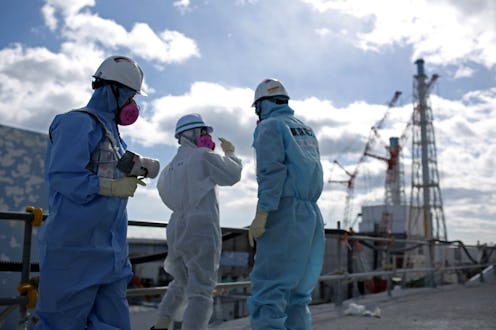News
How Safe Are America's Nuclear Reactors?
In the weeks following Japan's catastrophic Fukushima plant nuclear meltdown in 2011, U.S. Nuclear Regulatory Commission members evaded and misdirected questions about reactor safety at American nuclear plants, emails obtained by NBC through the Freedom of Information Act have revealed. The messages suggest that, while officials publicly hailed the safety records of stateside reactors, the behind-the-scenes conversation was quite different. Indeed, memos urged specific differences between "public" and "technical" talking points, with "public" statements leaving out relevant safety risks.
On the first weekend after the crisis, a NRC manager named Scott Burnell emailed his colleagues to voice appreciation that they weren't veering too far from the talking points the agency had distributed: "While we know more than these say, we're sticking to this story for now," he said.
Subtle.
It appears that the team weren't entirely sure that American reactors couldn't possibly see the same meltdown — which was not the clean, reassuring answer NRC officials wanted to give.
So, should we be worried? Well, the vast majority of America's nuclear plants are very old. Over half of them have been operating for 30-plus years, and some are running well beyond their projected lifespan. That's the sort of neglect that can see bad outcomes, like we've seen in recent years in the oil industry — the Texas City refinery disaster comes to mind — and within the last few years, regulators have considered approving older and older facilities for use.
With the Fukushima crisis in full swing, the NRC became nervous about upcoming regulatory announcements. This was highlighted by engineer Richard Barkey's concern about extending the license of a Boston plant called "Vermont Yankee."
That was a very scary picture to myself, much less the public, especially since the machine is a GE designed BWR (boiled-water reactor) not radically different in size, age and design than some high visibility plants in my region. I can see the cards and letters coming to my in-box by Monday.
Ultimately, the NRC did extend the license weeks later, though the plant is being shut down by its operator this year.
Perhaps the most striking instance of the NRC's seemingly public/private two-facedness is that of Eliot Brenner, their public affairs director, who memo'd staff telling them not to make any Japanese colleagues in direct touch with the situation in Fukushima available to the media.
While one reporter knows or has guessed that there are Japanese here in our Ops center in communication with their home authorities, we will NOT make the[m] available and we will NOT volunteer their presence. If anyone knows they are here and wants to talk with them, they will have to make the request through the embassy to have it relayed to these folks.
Wow.
Most worrisome of all, Brenner's memo acknowledged that the agency's Office of Nuclear Regulation had set about investigating the relative vulnerabilities of California's nuclear plants — Diablo Canyon in particular — which is prone, as the West Coast is, to earthquakes.
NRR is getting tasked with making an overlay of the Japanese conditions … to see how west coast plants stack up against it. We think preliminarily Diablo would have had no trouble with a wave that size. [For an earthquake of about] 8.9 we're not so sure about, but again we are not talking about that.
When it comes to matters of national security and environmental safety, "we are not talking about that" aren't words you really want to hear, are they?
The NRC, for its part, denies that the emails are revelatory of controversial, chalking them up to the intensity and urgency of the Japanese crisis. Brenner himself emailed NBC News with the following denial.
The NRC Office of Public Affairs strives to be as open and transparent as possible, providing the public accurate information in the proper context. We take our communication mission seriously. We did then and we do now. The frustration displayed in the chosen e-mails reflects more on the extreme stress our team was under at the time to assure accuracy in a context in which information from Japan was scarce to nonexistent. These e-mails fall well short of an accurate picture of our communications with the American public immediately after the event and during the past three years.
